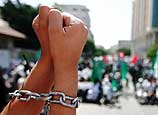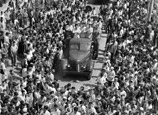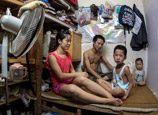
 |
| Shen Chongdao poses in front of a portrait of Chairman Mao. (GT/Cai Xianmin) |
Related:
>> Setting Mao in stone
The imposing portrait of Mao Zedong that looms over Tiananmen Square is one of China's most instantly recognizable images. However, not many people know the stories behind that iconic painting.
Ever since the portrait was first unveiled in Tiananmen Square at the founding ceremony of the People's Republic of China (PRC) on October 1, 1949, it has been replaced by a new copy almost every year on National Day. But the size of the portrait has basically remained unchanged since then. Measuring 6 meters high and 4.6 meters across, it is often assumed to be the largest portrait of Mao in China.
In fact, from the 1960s to the 1970s, People's Square in Shanghai had its own rotating portrait of Chairman Mao. They were much larger than the ones in Tiananmen Square, measuring 9 meters high and 6.9 meters wide.
From 1963 to 1978, on the eve of nearly every National Day, Shanghai-based painter Shen Chongdao would stand on a temporary scaffolding platform in People's Square for at least 10 days. His gray work clothes were always stained with paint. In front of him was a huge canvas on which a portrait of Chairman Mao would gradually appear. Shen was just one of the painters of the Mao portraits that hung in People's Square.
Although Shen never personally met the Great Helmsman, he saw Mao's face every day from 1963, when he graduated from Zhejiang Academy of Fine Arts (today's China Academy of Art), until 1978. Employed by the Lead Portrait Group of the Shanghai Arts and Design Company (SADC), Shen's job was to depict China's leader.
From the 1950s to the 1970s, SADC was one of only two organizations in China authorized to produce so-called "standard" images of the Chairman.
Every portrait of Mao had to strictly follow the likeness from a black and white photo of Chairman Mao shot in 1964, which was called No.4 Standard Picture of Mao Zedong. The portrait that hangs in Tiananmen Square today was also replicated from this No.4 photo.
"Our painters in that group perhaps couldn't be regarded as real artists at the time since we were not allowed to sign our names on any of the portraits we produced," Shen told the Global Times. "And all of our finished works were strictly examined by our leader, and later, they were sold in batches by factories, mines, schools and other government authorities."
To this day, Shen, now 74 years old, still considers what he did very honorable work. He emphasized to the Global Times that only the most outstanding graduates from professional art institutions were asked to paint Mao's image.
"Because of my exemplary academic record, my teacher at Zhejiang Academy of Fine Arts recommended me after I graduated," Shen said.
But Shen also admitted that he initially underestimated the work, which he said was very different from any of the portraits that he studied at art school. "Although there was a standard photo that we copied from, what many of us painted at first looked nothing like him," Shen said. "It took a year for me to get used to the work, which was much faster than other painters in the group."
Shen and the other five members of the Lead Portrait Group worked in a small studio at the Shanghai Culture Square on Yongjia Road.
"On the eve of each National Day, we were transferred to People's Square to draw huge standard portraits of Mao to replace the previous year's one. The largest size we made at that time was 9 meters high," Shen said.
During the 10 years of the Cultural Revolution (1966-1976), as the personality cult surrounding Chairman Mao intensified, the Lead Portrait Group's workload increased. Some of Shen's colleagues from other departments at SADC were transferred to his group to help them produce a relentless stream of Mao portraits.
In addition to portraits of Mao, Shen also portrayed the likenesses of figures as varied as Marx, Lenin, Engels and Sun Yat-sen.
"Of course, the portraits of Chairman Mao always hold a special emotional significance for me," Shen said. "When I was young, copies of Mao's portrait were hung not only in every workplace, but also in the bedrooms and dining rooms of every family's household."
One of Shen's proudest moments was when he was still in high school, and his teacher chose a Mao portrait that he had painted to hang on the front wall of the classroom.
"Although my talent was recognized early on, I never expected that I would one day do it for a living," Shen said.
Although he has been retired for many years, Shen continues to paint portraits of Mao from various time periods and is now very confident in his ability to depict Mao's likeness.
"The key is his eyes," Shen remarked, adding that they are the most distinctive and elusive features of Mao's face. "They can show his temperament as a national leader, but also his kindness."
Shen's Mao portraits that he painted after retiring are currently being exhibited at Beijing Tokyo Art Projects, a gallery in the capital's 798 Art Zone. Shen's son, Shen Weiqun, told us that he is negotiating the exhibition's next stop in Shanghai.
















 College student car models show youthful vigor
College student car models show youthful vigor


![]()
